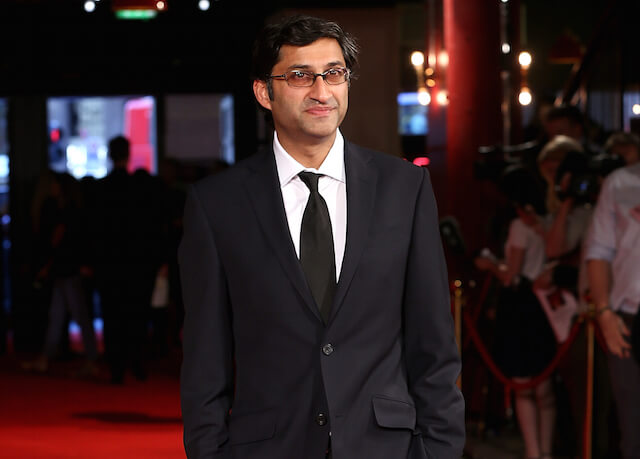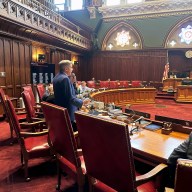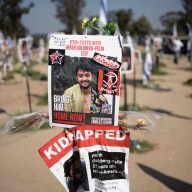Asif Kapadia didn’t know much about Amy Winehouse before he made “Amy,” the acclaimed new documentary about the late musician’s life. In a way that’s a good thing: his film recreates what it’s like to discover her for the first time. What you see is not the drug-addicted megastar who became a fixture of tabloids and late night one-liners. You see a funny, charismatic woman destroyed by a level of fame she never thought she could handle. And, just as in Kapadia’s doc “Senna,” you see it not through a traditional, expository Wikipedia movie but through an immersion in archival footage, from home movies to, in the film’s harrowing second half, horrifying paparazzi shots. We spoke to Kapadia as well as Nick Shymansky, Winehouse’s manager and close friend, about this unusual approach to a music doc. As someone who didn’t, like you, Asif, follow her career closely at the time, I was pretty blown away to see the footage of her younger and full of life. Asif Kapadia: That’s how I felt. I find myself always interested in making films about subjects I don’t know much about. Hopefully my initial feeling will be the audiences’ initial feeling. I want to appeal to people who have no interest in the subject, because the fans will probably go anyway. You want to appeal to people who aren’t the fans. With Amy, the first thing that stood out in Nick’s footage was how funny she was, and just comfortable, happy. I showed a really early cut to some friends, and they all cried in the beginning. They didn’t particularly cry at the ending, because they knew how it ended. Afterwards I asked why they were crying. They said, “Because we’d never seen her happy before.” All everyone remembers was her in the latter stages, and in the U.S. that’s all you saw. She was not the same person after she became famous. We wanted to show her doing really simple, mundane, ordinary things, so you realize she was this ordinary, down-to-earth, down-the-road girl and not put her on a pedestal and turn her into a megastar. Once that happens people become less human and easier to make fun of, easier to attack. I found her really engaging. When she sings a cappella, the rawness of it, I just fell in love with her. I wished I had met her. Was it difficult to get people like Nick involved? AK: I spoke to Nick. He was the first person to trust me, to open up and be willing to go on record. Everyone was nervous to speak to me — not willing, too pained, it was too soon. There were a lot of issues why they didn’t want to open up. They also didn’t know who I was. I could just be another paparazzi photographer or a journalist who’s going to change what they’re trying to say into something else. A lot of people felt they needed to shut down in order to protect Amy, because she had been exploited so much throughout her life. Nick, how did he convince you? Nick Shymansky: I was surprised by how unpushy Asif was. Everyone who had tried to talk to me had been very pushy. I wasn’t sure about it at first. I’d seen “Senna,” so I had a respect. I wanted to meet up and express my concerns. I found that Asif wasn’t looking for a hook, he wasn’t trying to get something done quickly. I was given time to come round. By the time I got into a recording booth I felt I had a relationship with Asif — that this was the most comfortable I was ever going to feel getting into a booth and talking about Amy. He had a very sensitive way of handling people who had been around something as sad as what happened to her. There’s an unusual amount of intimacy here, particularly because of the footage shot by people like Nick. AK: What’s interesting about Nick and her friend Lauren’s material is it’s really intimate. It’s also something to do with the cameras they’re using. They’re not cameraphones. They’re home video cameras, so you have to hold them up to your eye. If you hold it up to your eye and you’re talking to Amy, she’s looking straight at us, into the lens. That’s another level of intimacy. She’s talking to the audience. We are the friend, we are Nick, we are Lauren, we are the husband, we are the paparazzi. We become all these people. The audience changes their point of view with Amy throughout the film. It’s worth noting that people don’t really use those kinds of cameras anymore. Today we all use our smartphones, and we may just use Twitter or Instagram instead of filming it all. AK: It’s hard to imagine there was a life before the iPhone. This film is really recent, yet the footage was before the iPhone. And the footage has come from — I’ll be honest — middle class kids, who had cameras at home. A lot of poor kids would not have cameras. They were able to film stuff because their parents had cameras. The interesting thing is with that kind of stuff they filmed back then, you’d shoot it, you’d put it on a shelf and you’d forget it. A bit of time has to pass. What happens today is you shoot and you go, “I don’t like the way I look,” and you delete it. It was a very different time from how people are filming now. NS: I’ve always filmed everything. You always intend to watch it, but I never did. When these things become important — if you lose a grandparent — then you want to go back and see it. It’s not important to you until the real thing is not around anymore. That’s what happened with [the footage of Amy he shot]. I didn’t think about it until I met Asif, and I thought, ‘S—, I probably do have some really good bits.’ Like “Senna,” “Amy” completely avoids “talking heads,” the term for shots in documentaries or news broadcasts that are just people talking. I know you have an arts school background, but did your aversion come from somewhere else? AK: I worked in TV for a bit where all I did was shoot talking heads. And I hated it, and I quit my job. I’m anti that style of filmmaking. Doesn’t mean I won’t do it one day; doesn’t mean other people don’t do it brilliantly. It just means it doesn’t work for me. [This style] started with “Senna.” I didn’t know a lot about the subject, so I thought the worst thing I could do was turn up with a camera for an interview with someone who’s been interviewed a lot and not know what the hell I’m talking about. I needed to do research, and the way I do research is by looking at the material. I don’t do research by reading books. I’m a filmmaker. I need to look at the footage. And I looked at the footage and it just looked mad, amazing. It was all there. It was an epiphany where I thought, “This is one of the greatest sets of dailies I’ve ever seen. I cannot believe no one’s ever put it together.” So I put it together. I would show people and they would say, “Amazing! But you still need to interview someone.” I’m a big fan of certain directors like Hitchcock who don’t shoot coverage. Don’t shoot something you don’t intend to use. So I would not shoot interviews, because I didn’t intend to use them. I was going to prove to everyone this film can be done in a different way. You’re dealing with people who died, so you want the audience to forget they’ve died. You want them to feel like it’s in the present. The film takes their point of view. “Amy” is a continuation of that. It’s about her. She’s got to be the center. If I don’t have an interview with her I’ve got to find a way to still put her at the center of the story. It was much more difficult making a film using only archive, because the easiest thing in the world when you’ve got a gap in your story is to go interview someone. You cut to a talking head and you fill in a blank. It saves you months, maybe years. But I’m stubborn. And hopefully it’s more cinematic. I want to make movies for the big screen. I want the audience to see it in a theater and experience a feeling and an emotion. For me, talking heads, that’s television.
Asif Kapadia on making his friends cry with his Amy Winehouse doc

Follow Matt Prigge on Twitter @mattprigge


















